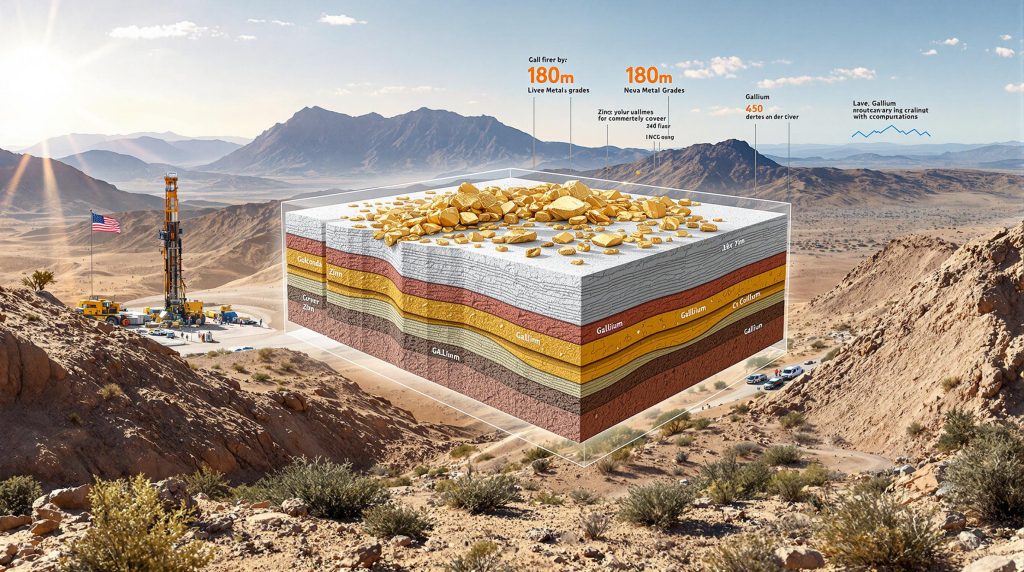What is the Golconda Discovery and Why Does it Matter?
G50 Corp's recent exploration at the Golconda project in Arizona has revealed a significant polymetallic discovery containing both precious and strategic metals. This district-scale find represents an important development in the North American mining trends, combining traditional precious metals with strategic elements crucial for advanced technologies and renewable energy applications.
The discovery spans a 700-meter corridor of shallow polymetallic mineralization, with multiple stacked zones extending from surface to 180 meters depth. What makes this find particularly significant is the consistent gallium intercepts across all tested areas, alongside increasing gold grades observed at deeper levels.
As G50 Corp's Managing Director Mark Wallace explained, "The combination of polymetallic mineralization, extensive strike length, high-grade intercepts and increasing gold grades at depth highlights the project's importance and potential."
Key Discovery Highlights
- 700-meter corridor of shallow polymetallic mineralization
- Multiple stacked zones from surface to 180m depth
- Consistent gallium intercepts across all tested areas
- Increasing gold grades observed at depth
- Located within a broader 3km mineralized trend
Geological Context of the Golconda Project
The Golconda project is strategically situated on a 20km-long crustal structure in Arizona's Basin and Range province. The area exhibits characteristic features of a mesothermal polymetallic vein system, suggesting a significant hydrothermal mineral-forming event occurred in the region's geological past.
The project encompasses multiple historic mining areas including Golconda, Primrose, and Big Bethel, which collectively form part of a 3km mineralized trend. This historical mining context adds confidence to the current exploration results while providing valuable insights into the broader mineralization patterns.
What makes the Golconda project particularly promising is its potential for both near-surface extraction and deeper exploration upside, as indicated by the increasing gold grades at depth. This dual opportunity presents G50 Corp with multiple development pathways as the project advances.
What Metals Were Found in the Golconda Discovery?
The Phase 2 drilling program insights at Golconda revealed a diverse mix of metals with significant economic potential. This polymetallic profile positions the project as a potential source of both precious metals and strategic elements – a combination that has become increasingly valuable in today's technology-driven economy.
Precious Metals Profile
- Gold grades ranging from 0.37 g/t to 5.2 g/t in various zones
- Silver values up to 256 g/t in high-grade internal zones
- Evidence of increasing gold grades at depth
- Changing silver-to-gold ratios in deeper sections indicating potential for higher-grade zones
The precious metals component provides a solid foundation for the project's economic potential, with gold and silver representing well-established commodities with stable market demand. The observation that gold grades appear to increase with depth is particularly encouraging, suggesting the potential for higher-grade resources as exploration continues.
Strategic Metals Composition
- Consistent gallium grades around 18-19 g/t over extensive intervals
- Highest gallium intercept measuring 204m at 18.1 g/t from near-surface
- Zinc concentrations up to 9.8% in high-grade zones
- Copper values reaching 0.28% in selected intervals
The strategic metals component, particularly the gallium mineralization, represents a significant value-add to the project. Gallium's growing importance in semiconductor manufacturing, 5G infrastructure, and clean energy technologies has increased its strategic value, especially given supply concerns related to concentrated global production.
Metallurgical Advantages
- Approximately 90% of gallium hosted in sericite
- Favorable mineralogy and mining economics
- Potential for selective concentration and leaching
- Opportunity for multi-metal recovery system
G50 has highlighted that the sericite-hosted gallium mineralization represents "an outstanding characteristic" for extraction purposes. This mineralogical feature could significantly impact processing economics, potentially allowing for more efficient recovery of this strategic metal alongside the conventional precious and base metals.
What Were the Most Significant Drill Results?
The Phase 2 drilling program delivered several standout intercepts across multiple zones, confirming the project's potential for both bulk tonnage and high-grade targets. These results provide concrete evidence of the project's mineralization style and economic potential.
Tub Vein Zone Highlights
- 32m at 0.61 g/t gold, 18.15 g/t silver, 4.21% zinc and 0.11% copper from 9.1m (GRC 30)
- Higher-grade section: 12.2m at 1.5 g/t gold, 41 g/t silver, 9.8% zinc and 0.28% copper
- Near-surface mineralization providing potential for early extraction
The Tub Vein Zone results are particularly significant due to their near-surface location, which could translate to lower stripping ratios and potentially earlier cash flow in any future mining scenario. The polymetallic nature of these intercepts also demonstrates the multi-commodity potential of the project.
Tub Footwall Zone Results
- 19.8m at 0.37 g/t gold and 44.26 g/t silver from 128m depth
- Internal high-grade zones reaching 1 g/t gold and 256 g/t silver
- Deeper mineralization showing improved precious metal values
The Tub Footwall Zone represents a deeper mineralized horizon with particularly strong silver values. The presence of high-grade internal zones within broader mineralized envelopes suggests potential for both bulk mining approaches and selective high-grade extraction strategies.
Previous High-Grade Intercepts
- 35m at 5.2 g/t gold in hole GRC 06
- 47.2m at 2 g/t gold in hole GRC 22
- These results warrant follow-up exploration to define extent and continuity
The previously reported high-grade gold intercepts from holes GRC 06 and GRC 22 represent some of the most economically significant results from the project to date. The substantial widths of these high-grade zones (35m and 47.2m respectively) are particularly noteworthy, as they suggest potential for meaningful gold resources if continuity can be established through further drilling.
How Extensive is the Gallium Mineralization?
The gallium component of the G50 Corp discovery in Golconda represents a potentially significant strategic resource, with consistent grades across a substantial area. In today's technology-driven economy, this gallium mineralization could provide important supply diversification for a critical element in semiconductor and clean energy applications.
Gallium Distribution and Grades
- All 12 Phase 2 holes targeting gallium returned significant values
- Most holes recorded grades around 18-19 g/t gallium
- Mineralized intervals frequently exceeded 150 meters
- Highest intercept: 204m at 18.1 g/t gallium from 9.2m depth
The consistency of gallium grades across the tested area is particularly noteworthy. The 18-19 g/t grade, while requiring comparison to global benchmarks, appears significant given the extensive widths of mineralization and the near-surface position of many intercepts.
The 204-meter intercept starting from just 9.2m depth represents one of the most extensive gallium mineralized zones reported to date, highlighting the potential scale of the resource.
Metallurgical Characteristics
- 90% of gallium hosted in sericite mineral
- Described by G50 as "an outstanding characteristic" for extraction
- Amenable to conventional processing routes
- Potential for commercial recovery alongside precious and base metals
The sericite-hosted nature of the gallium mineralization could prove advantageous from a processing perspective. Sericite is a phyllosilicate mineral that typically responds well to conventional mineral processing techniques, potentially allowing for cost-effective gallium recovery as part of a multi-metal extraction process.
Strategic Importance of Gallium
- Critical component in semiconductor manufacturing
- Essential for 5G technology, LEDs, and solar panels
- Limited global production concentrated in few countries
- Growing demand from technology and renewable energy sectors
Gallium's strategic importance continues to grow as technology evolves. Its applications in semiconductor manufacturing make it crucial for advanced electronics, while its role in LEDs and solar panels connects it directly to the clean energy transition. With limited global production sources, new discoveries like Golconda could play an important role in supply diversification.
What is the Geological Setting of the Golconda Project?
The Golconda project's geological characteristics provide important context for understanding the discovery's potential scale and economic significance. The geological setting offers clues about the formation processes, potential scale, and exploration upside of the mineralized system.
Regional Structural Framework
- Located on a 20km-long crustal structure in Arizona
- Situated within the Basin and Range geological province
- Part of a broader metallogenic belt known for polymetallic deposits
- Contains multiple historic mining areas along a 3km trend
The 20km crustal structure represents a major regional feature that likely played a key role in focusing mineralizing fluids. The Basin and Range province is characterized by extensional tectonics that created numerous fault systems capable of channeling metal-bearing fluids from deep in the earth's crust to shallower depositional environments.
Mineralization Style and Controls
- Classified as a mesothermal polymetallic vein system
- Distinctive alteration features indicating hydrothermal processes
- Multiple stacked mineralized zones from surface to 180m depth
- Favorable host lithologies for precious and strategic metal deposition
The mesothermal classification provides important insights into the temperature and pressure conditions under which the mineralization formed. Mesothermal systems typically form at moderate depths and temperatures, often resulting in more extensive and continuous mineralization compared to epithermal (shallow) systems.
The stacked nature of the mineralized zones suggests multiple mineralizing events or pulses, potentially increasing the overall resource potential of the system.
Exploration Model Implications
- Gold grades appear to increase with depth
- Silver-to-gold ratio changes visible in cross-sections
- Potential for discovering additional parallel structures
- System remains open along strike and at depth
The observation of increasing gold grades with depth is particularly significant from an exploration perspective. This pattern could indicate the potential for higher-grade gold mineralization at deeper levels, possibly suggesting proximity to the source of the mineralizing fluids as exploration progresses downward.
The changing silver-to-gold ratios seen in cross-sections may represent metal zonation within the system, a common feature in polymetallic deposits that can help guide future exploration efforts.
What's Next for the Golconda Project?
G50 Corp has outlined a comprehensive forward program to advance the Golconda discovery through further exploration, metallurgical testing, and preliminary development steps. This multi-faceted approach aims to systematically de-risk and advance the project.
Planned Drilling Programs
- Follow-up diamond and RC drilling to test strike extensions
- Deeper drilling to explore increasing gold grades at depth
- Specific follow-up on high-grade intercepts from GRC 06 and GRC 22
- Potential resource definition drilling in established zones
The planned drilling programs balance several objectives: testing the lateral extent of known mineralization, exploring the potential for higher gold grades at depth, following up on the highest-grade intercepts to establish continuity, and systematic infill drilling to support future resource estimation.
This balanced approach allows for both resource growth and increased confidence in areas of known mineralization.
Technical Studies Underway
- Metallurgical test work on gallium, gold, and base metals
- Process development for multi-metal recovery
- Assessment of selective concentration and leaching methods
- Preliminary economic evaluation of various extraction scenarios
The metallurgical and processing studies represent critical path activities for advancing the project. Understanding the recovery characteristics of the various metals, particularly the gallium component, will be essential for establishing the economic parameters of any future development scenario.
The multi-metal nature of the deposit requires careful optimization of processing routes to maximize overall metal recoveries and economic returns.
Environmental and Permitting Activities
- Commencement of baseline environmental studies
- Early permitting works to establish development pathway
- Stakeholder engagement and community relations
- Sustainability planning for potential future operations
By initiating environmental baseline studies early in the project timeline, G50 Corp demonstrates a forward-looking approach to development. Understanding environmental conditions and establishing positive stakeholder relationships from the outset can significantly reduce permitting risks and timelines as the project advances.
How Does This Discovery Compare to Similar Projects?
The Golconda discovery exhibits several distinctive characteristics that position it within the broader context of polymetallic and strategic metal projects globally. While direct comparisons require careful consideration of geological, geographical, and economic factors, several aspects of the Golconda discovery stand out.
Unique Aspects of the Golconda Discovery
- Combination of precious metals with strategic elements
- Consistent gallium grades over substantial widths
- Near-surface mineralization with potential for low strip ratio
- Multiple stacked zones providing exploration flexibility
The polymetallic nature of the Golconda discovery, particularly the combination of conventional precious and base metals with strategic elements like gallium, represents a distinctive feature. This multi-commodity profile potentially reduces single-metal price risk while providing exposure to both established and emerging markets.
Comparative Advantages
- Favorable jurisdiction in Arizona, USA
- Proximity to existing infrastructure
- Potential for multiple revenue streams from diverse metals
- Strategic metals component enhancing project economics
Arizona represents a mining-friendly jurisdiction with established regulatory frameworks and access to skilled labor and services. The state's long mining history has created well-developed infrastructure networks that can reduce capital requirements for new projects.
The multi-metal nature of the deposit creates potential for diverse revenue streams, potentially allowing for more stable economic performance across metal price cycles.
Market Positioning
- Addressing growing demand for critical minerals outlook in North America
- Potential contribution to domestic supply chain security
- Alignment with green technology and renewable energy sectors
- Diversified metal profile reducing single-commodity risk
The Golconda project's gallium component aligns with growing interest in domestic critical mineral supply chains, particularly in North America where concerns about supply security have increased in recent years. The project's potential contribution to gallium supply diversification could be strategically significant given the metal's importance in semiconductor and clean energy applications.
What is the Significance of Gallium in Modern Technology?
Gallium represents a critical component of the Golconda discovery, with applications across multiple high-tech and renewable energy sectors. Understanding gallium's technological significance provides important context for evaluating the strategic value of the Golconda discovery.
Key Applications of Gallium
- Essential component in semiconductor manufacturing
- Used in gallium arsenide (GaAs) and gallium nitride (GaN) compounds
- Critical for 5G telecommunications infrastructure
- Fundamental to LED lighting technology
- Important in solar panel production
- Used in medical imaging equipment
Gallium's technological importance stems from its unique properties when combined with other elements. Gallium arsenide (GaAs) and gallium nitride (GaN) semiconductors offer advantages over silicon in specific applications, particularly those requiring high-frequency operation or light emission/detection.
The expansion of 5G telecommunications networks has increased demand for gallium-based semiconductors capable of handling the higher frequencies required for next-generation communications.
Supply Chain Considerations
- Global production dominated by a small number of countries
- Often recovered as a by-product of aluminum and zinc processing
- Limited dedicated gallium mining operations worldwide
- Growing concerns about supply security for critical technologies
Gallium supply chains present several challenges. Most gallium is produced as a by-product of aluminum refining, with a smaller amount recovered from zinc processing. This production model means gallium supply is largely dependent on aluminum and zinc markets rather than responding directly to gallium demand.
The concentration of production in a limited number of countries creates potential supply security concerns for industries dependent on gallium-based technologies.
Market Outlook
- Projected demand growth driven by telecommunications expansion
- Increasing use in electric vehicle components
- Rising importance in renewable energy applications
- Strategic value enhanced by supply concentration risks
The outlook for gallium demand appears positive, supported by growth in multiple technology sectors. The ongoing rollout of 5G telecommunications infrastructure continues to drive demand for gallium-based semiconductors, while applications in electric vehicles and renewable energy are creating additional demand vectors.
These growing applications, combined with the concentrated nature of current supply, enhance gallium's strategic importance and the potential value of new sources like the Golconda discovery.
FAQ: Understanding G50 Corp's Golconda Discovery
What metals were discovered at the Golconda project?
The Golconda project contains a polymetallic mineral system with gold, silver, zinc, copper, and gallium. The most significant intercepts include zones with up to 5.2 g/t gold, 256 g/t silver, 9.8% zinc, and consistent gallium grades around 18-19 g/t over extensive intervals.
Where is the Golconda project located?
The Golconda project is located in Arizona, USA, within the Basin and Range geological province. It sits on a 20km-long crustal structure and includes several historic mining areas including the Golconda, Primrose, and Big Bethel mines along a 3km mineralized trend.
What makes gallium a strategic metal?
Gallium is considered strategic due to its essential role in semiconductor manufacturing, 5G telecommunications, LED lighting, and solar panels. Global production is limited and concentrated in few countries,
Ready to Capitalise on the Next Major Mineral Discovery?
Stay ahead of the market with real-time alerts on significant ASX mineral discoveries through Discovery Alert's proprietary Discovery IQ model, transforming complex mineral data into actionable investment insights. Visit the Discovery Alert discoveries page to understand why major mineral discoveries like Golconda can lead to substantial market returns, and begin your 30-day free trial today.




